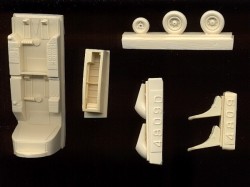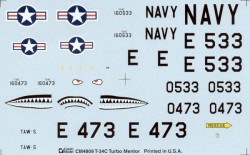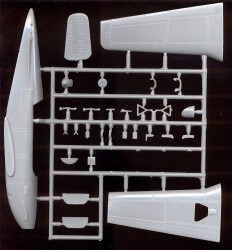Czech Model 1/48 Beechcraft T-34C Turbo Mentor
By Michael Benolkin
 |
Background
Beechcraft developed the Model 45 tandem seat military primary trainer using proven components from their Bonanza production line. Powered by a six-cylinder O-470 engine rated at 225 horsepower, the USAF procured 450 as the T-34A Mentor and the USN would buy 423 as the T-34B. From a pilot’s point of view, the only real difference between the two aircraft was the Air Force version used a carbureted engine whereas the Navy opted for a fuel-injected engine. If you had the opportunity to fly both types and forgot which one you were starting, it was all too easy to flood the engine and/or wear down the battery trying to get the engine lit off.
The T-34C was a further development for the US Navy to adapt a Pratt & Whitney PT6A turboprop engine de-rated to 400 shaft horsepower to the Mentor airframe and provide aspiring Naval Aviators with pure turbine-powered training from day one. The first T-34Cs entered service in 1977. Compared to the 225 hp T-34A/B Mentor, the T-34C is the sport model of the Mentor family.
Beechcraft developed a derivative of the T-34C, dubbed T-34C-1, which incorporated underwing pylons and additional power to carry more weight aloft. The T-34C-1 was targeted as an advanced trainer, forward air control (FAC) platform and counter-insurgency (COIN) for international sales. This version of the Mentor has been sold to at least Taiwan, Morocco, Ecuador, Indonesia, Peru and Argentina.
The Kit
Until now, the only kit options for the Mentor was the Hasegawa 1/72 T-34A/B or the not inexpensive all-resin Sky Models 1/48 T-34C. Thanks to the combined efforts of Squadron and Czech Model, we have an inexpensive alternative for a T-34C in 1/48 scale.
The Czech Model T-34C is a multimedia kit, with the fuselage, wings, tail, and landing gear molded in light gray injection-molded styrene. The cockpit tub, seats, nosewheel well, and engine exhaust ducts are cast in resin by True Details. In true Squadron style, two complete vacuformed canopies are included, giving me one to work with and a compulsory spare when Murphy’s Law prevails.
As you can see in the accompanying photos, the detail in the wings and fuselage is all finely scribed, with the unique indents in the flight control surfaces that strengthen the structure all captured beautifully. You’ll note that the kit provides you with your choice of styrene or resin wheels. As the styrene nosewheel is pre-cast onto the nosegear strut, an additional nosegear strut is provided sans wheel to accommodate the resin nosewheel.
 A few notes on construction: first, take heed of the weight needed in the nose. This kit will be a dedicated tail-sitter without sufficient ballast up front. Second, the instructions would have you assemble the propeller in a ‘normal’ position. T-34Cs (and PT6 engines in general) feather the propeller at shutdown. Check out the numerous T-34C photos on the internet to see what I mean. Lastly, the prominent clear lenses out on the wingtips are not provided in this kit. Inside these lenses are the red/green navigation lights and the anti-collision strobe lights. You might consider notching out the wingtips and inserting your own clear lenses. Parts B18 that appear to be wing fences out near the wingtips are actually shields to protect the pilot’s eyes from those strobe lights whilst engaging in night flight.
A few notes on construction: first, take heed of the weight needed in the nose. This kit will be a dedicated tail-sitter without sufficient ballast up front. Second, the instructions would have you assemble the propeller in a ‘normal’ position. T-34Cs (and PT6 engines in general) feather the propeller at shutdown. Check out the numerous T-34C photos on the internet to see what I mean. Lastly, the prominent clear lenses out on the wingtips are not provided in this kit. Inside these lenses are the red/green navigation lights and the anti-collision strobe lights. You might consider notching out the wingtips and inserting your own clear lenses. Parts B18 that appear to be wing fences out near the wingtips are actually shields to protect the pilot’s eyes from those strobe lights whilst engaging in night flight.
 Markings are provided for two aircraft:
Markings are provided for two aircraft:
-
BuNo 160473 with a cool sharkmouth on the nose and a ‘sporty’ variation of the trainer color layout.
-
BuNo 160533 with a more ‘classic’ trainer appearance.


